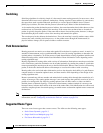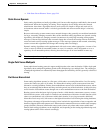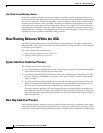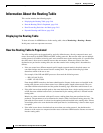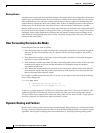
24-3
Cisco ASA 5500 Series Configuration Guide using ASDM
Chapter 24 Routing Overview
Information About Routing
• Link-State Versus Distance Vector, page 24-4
Static Versus Dynamic
Static routing algorithms are hardly algorithms at all, but are table mappings established by the network
administrator before the beginning of routing. These mappings do not change unless the network
administrator alters them. Algorithms that use static routes are simple to design and work well in
environments where network traffic is relatively predictable and where network design is relatively
simple.
Because static routing systems cannot react to network changes, they generally are considered unsuitable
for large, constantly changing networks. Most of the dominant routing algorithms are dynamic routing
algorithms, which adjust to changing network circumstances by analyzing incoming routing update
messages. If the message indicates that a network change has occurred, the routing software recalculates
routes and sends out new routing update messages. These messages permeate the network, stimulating
routers to rerun their algorithms and change their routing tables accordingly.
Dynamic routing algorithms can be supplemented with static routes where appropriate. A router of last
resort (a router to which all unroutable packets are sent), for example, can be designated to act as a
repository for all unroutable packets, ensuring that all messages are at least handled in some way.
Note There is no dynamic routing support in multi-context mode. As a result, there is no route tracking.
Single-Path Versus Multipath
Some sophisticated routing protocols support multiple paths to the same destination. Unlike single-path
algorithms, these multipath algorithms permit traffic multiplexing over multiple lines. The advantages
of multipath algorithms are substantially better throughput and reliability, which is generally called load
sharing.
Flat Versus Hierarchical
Some routing algorithms operate in a flat space, while others use routing hierarchies. In a flat routing
system, the routers are peers of all others. In a hierarchical routing system, some routers form what
amounts to a routing backbone. Packets from nonbackbone routers travel to the backbone routers, where
they are sent through the backbone until they reach the general area of the destination. At this point, they
travel from the last backbone router through one or more nonbackbone routers to the final destination.
Routing systems often designate logical groups of nodes, called domains, autonomous systems, or areas.
In hierarchical systems, some routers in a domain can communicate with routers in other domains, while
others can communicate only with routers within their domain. In very large networks, additional
hierarchical levels may exist, with routers at the highest hierarchical level forming the routing backbone.
The primary advantage of hierarchical routing is that it mimics the organization of most companies and
therefore supports their traffic patterns well. Most network communication occurs within small company
groups (domains). Because intradomain routers need to know only about other routers within their
domain, their routing algorithms can be simplified, and, depending on the routing algorithm being used,
routing update traffic can be reduced accordingly.










